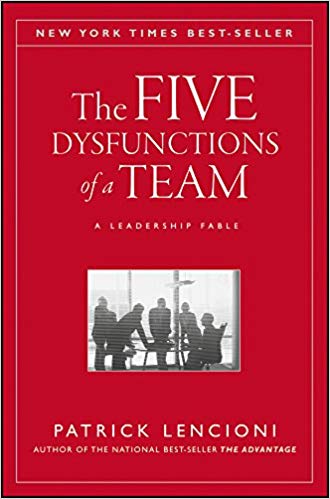

This article is an excerpt from the Shortform summary of "The Five Dysfunctions of a Team" by Patrick Lencioni. Shortform has the world's best summaries of books you should be reading.
Like this article? Sign up for a free trial here .
Does your team or workplace have lack of commitment? Is your team unable to choose a plan and stick to it? How do you deal with this so you can create commitment and buy-in? Learn tips from 5 Dysfunctions of a Team.
Teams need to be committed and on the same page in order to succeed. There can be no ambiguity around what goals the organization is trying to achieve, and all team members must fully buy in to the plan. Most importantly, they must decide.
Dysfunctional teams, however, fail to achieve commitment and lumber from one non-decision to the next. Their lack of commitment leads them to a standstill.
This problem of lack of commitment stems from a fear of conflict. When teammates haven’t had the opportunity to hash out disagreements through productive, ideological debate, they feel that their ideas haven’t been proper consideration. It is also harder to make any decision when alternative points of view have not been considered, because it feels there might be better options that lay undiscovered. The result is a lack of commitment: ambiguity about goals, confusion regarding individual responsibilities, and indecision.
Lack of commitment also stems from a desire for consensus and certainty.
Consensus—universal agreement—is impossible to achieve and is actually counterproductive. Striving for it will only waste valuable time and end up producing false consensus, in which alternative points of view remain undiscussed (which also increases the possibility that flaws in the plan will go undetected). A desire for consensus causes lack of commitment in a team.
Certainty—or wanting to know 100% what all the effects of any decision will be—is likewise impossible to achieve. Teams that try to achieve this end up wasting time and energy in round after round of analysis and delay. As a result teams, lose focus and confidence in their decision-making, and become unable and unwilling to commit to anything. A decision is better than no decision. Waiting for 100% answers causes lack of commitment in a team.
Teams that suffer from a lack of commitment squander opportunities through their indecision, fail to keep their members on the same page about priorities and results, waste time revisiting the same topics over and over again, spread confusion to subordinates within the organization, and over time, lose the ability to commit to any decisions at all.
Lack of Commitment Example 1
Kathryn shares an anecdote about her how her husband’s high school basketball coaching methods. While he is the leader and has final say on how games and practices will be run, he allows each member of the team to voice their concerns and objections to any particular plan. He always provides an explanation for why he’s making a decision—creating the conditions for buy-in and clarity.
Lack of Commitment Example 2
Kathryn demonstrates to the team that there is no clarity around what the overarching goal should be for the rest of the year. Each member of the team believes that their area of expertise is the most important and should receive highest priority (i.e., Martin in engineering believes that it’s product improvement, Jan in finance says it’s cost containment, JR and Nick push for market share). Since they don’t trust each other and don’t resolve their disagreements through constructive debate, the result is a lack of buy-in and total ambiguity on what their priority should be. Everyone continues to work in silos, individual efforts are not harnessed to a common purpose, and the same discussions continue to take place with no resolution in sight.
Solving Lack of Commitment: Fostering Commitment
To solve the dysfunction of lack of commitment, teams need to create clarity around specific responsibilities and expectations and encourage decisiveness. Below are some tools that can help teams move in this direction.
Lack of Commitment Strategy 1: Cascading Messaging
At the end of every meeting, review key decisions and agree on what needs to be communicated to stakeholders who were not at the meeting. Think through the messaging to each successive layer of the organization. This reveals any points of disagreement between the team and fosters clarity about next steps. It also gives clear instructions on what should be conveyed to subordinates, so that all parts of the organization are receiving the same message.
Lack of Commitment Strategy 2: Deadlines
Assign clear timing around project deliverables. This will reduce ambiguity, since everyone will know when and what they are expected to deliver. Deadlines must be rigorously enforced, both for final and intermediate decisions, so that team members can remain in sync throughout the full life cycle of a project.
Lack of Commitment Strategy 3: Contingency and Worst-Case Scenario Analysis
Explore alternative courses of action, while modeling for the worst possible outcome.
Doing so encourages teams to make decisions, since they will know that there is always a way to change course if they’re on the wrong path.
Worst-case scenario analysis demonstrates that downsides to a decision are seldom as bad as an overly cautious team might think they are. This eliminates the need for absolute certainty before committing to a decision and increases decisiveness.
Lack of Commitment Strategy 4: Low-Risk Exposure Therapy
Display decisiveness in low-risk areas before applying it to more consequential decisions. Start with decisions that have lower stakes, where the worst-case scenario is not all that bad.
Like the tactics above, this can demonstrate how much teams underrate their own decision-making capacity.
———End of Preview———

Like what you just read? Read the rest of the world's best summary of Patrick Lencioni's "Five Dysfunctions of a Team" at Shortform . Learn the book's critical concepts in 20 minutes or less .
Here's what you'll find in our full Five Dysfunctions summary :
- What the Five Dysfunctions are
- Why absence of trust is the fundamental dysfunction
- How to get people to argue the right way
- Strategies and exercises to overcome each dysfunction






